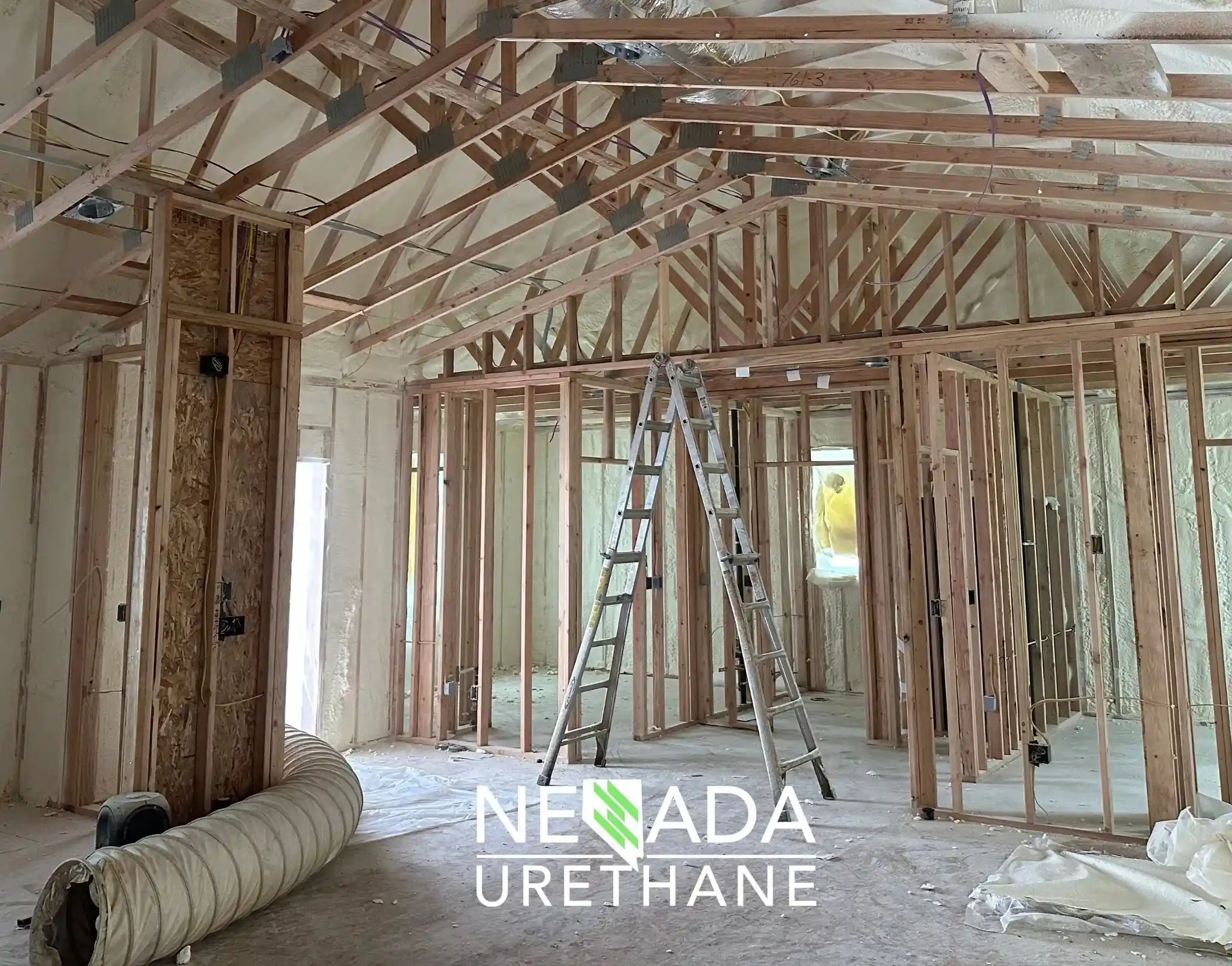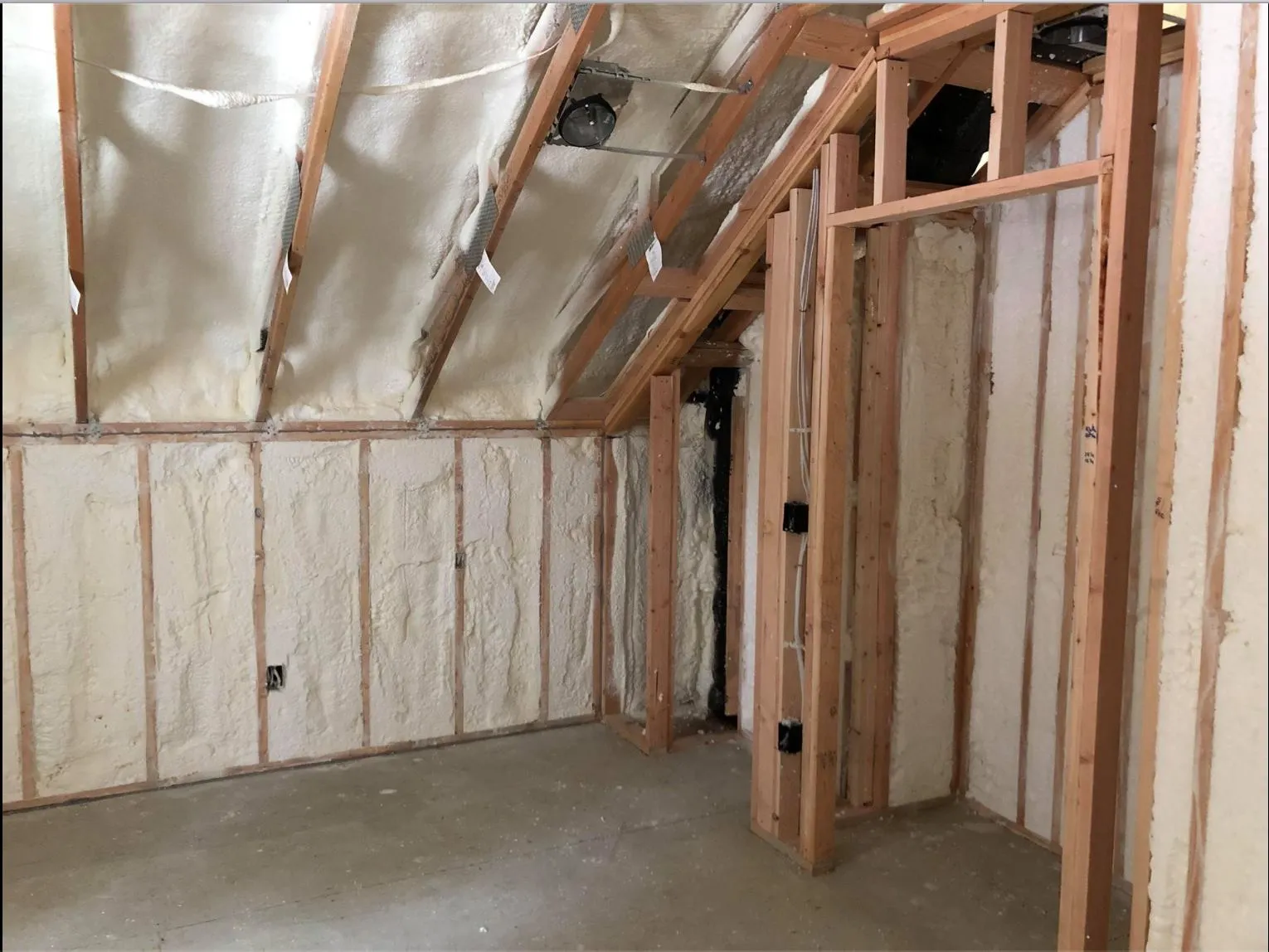
Reno homes achieve substantial energy savings through spray foam insulation by creating an airtight thermal barrier that reduces heating and cooling costs by 20-50% annually. This advanced insulation method seals gaps and cracks that traditional materials cannot reach, while providing superior R-values ranging from R-6 to R-7 per inch compared to fiberglass batts at R-3.2 per inch.
The effectiveness stems from spray foam’s ability to expand and conform to irregular surfaces, eliminating thermal bridging and air infiltration that plague conventional insulation systems. Nevada Urethane has observed consistent energy reductions across residential projects, with homeowners reporting lower utility bills within the first month of installation.
Reno’s high desert climate presents unique challenges with temperature swings exceeding 40°F between day and night during the shoulder seasons. Spray foam insulation addresses these conditions by maintaining consistent indoor temperatures regardless of external fluctuations.
Bonus Tip: Install spray foam during moderate weather months (April-May, September-October) when temperature stability allows optimal curing and expansion rates.
The closed-cell formula creates a moisture barrier that prevents condensation issues common in traditional insulation systems. This dual function reduces energy waste from humidity control while protecting structural elements from moisture damage.
| Insulation Type | R-Value per Inch | Air Sealing | Moisture Resistance | Longevity |
|---|---|---|---|---|
| Closed-Cell Spray Foam | R-6 to R-7 | Excellent | Superior | 50+ years |
| Open-Cell Spray Foam | R-3.6 to R-4 | Very Good | Good | 30+ years |
| Fiberglass Batts | R-3.2 to R-3.8 | Poor | None | 15-20 years |
| Cellulose | R-3.2 to R-3.8 | Fair | Moderate | 20-30 years |
Attic applications yield the highest energy savings since heat rises and accumulates in upper levels. Spray foam prevents stack effect air movement that forces HVAC systems to work harder, maintaining comfortable temperatures.
Wall cavity installations eliminate convective loops within stud bays, a phenomenon where air circulates within insulation gaps, reducing thermal effectiveness. The seamless application prevents settling and compression issues that degrade performance over time.
Basement and crawl space treatments address ground moisture infiltration while insulating foundation walls. This approach reduces heating loads during winter months when ground contact creates significant thermal losses.
| Application Area | Energy Savings | Installation Depth | Payback Period |
|---|---|---|---|
| Attic Floor | 30-40% | 6-10 inches | 3-5 years |
| Wall Cavities | 20-30% | 3.5-5.5 inches | 5-7 years |
| Basement/Crawl | 15-25% | 2-4 inches | 6-8 years |
| Roof Deck | 35-45% | 4-8 inches | 4-6 years |
According to the U.S. Department of Energy, proper air sealing and insulation improvements can reduce heating and cooling costs by up to 15% annually. The North American Insulation Manufacturers Association reports that spray foam insulation maintains 95% of its R-value after 20 years, compared to 85% for traditional materials.
Surface preparation determines long-term performance and energy savings potential. Clean, dry surfaces allow proper adhesion and prevent air leaks that compromise thermal barriers. Temperature and humidity conditions during application affect foam expansion and curing rates.
Bonus Tip: Schedule installation when ambient temperatures remain between 60-80°F for 24 hours to ensure optimal foam chemistry and expansion characteristics.
Proper ventilation planning prevents moisture accumulation in enclosed spaces. Closed-cell applications require different ventilation strategies than open-cell systems due to vapor permeability differences.
Code compliance varies by application area and local building requirements. Professional installation ensures adherence to fire rating specifications and thermal barrier coatings where mandated.
Existing insulation removal may be necessary depending on the current material condition and contamination levels. Damaged or wet insulation reduces new spray foam and can create moisture problems.
Electrical and plumbing modifications should be completed before foam application since accessing embedded utilities becomes difficult after installation. HVAC system sizing may require adjustment due to improved home tightness and reduced heating and cooling loads.
Budget planning should account for air sealing benefits that may necessitate additional ventilation improvements. Homes with significant air leakage reduction often need mechanical ventilation upgrades to maintain indoor air quality.

Nevada Urethane provides comprehensive insulation solutions tailored to Reno’s climate conditions and energy efficiency requirements.
Remove existing insulation if damaged or contaminated, seal major air leaks in framing, complete electrical and plumbing work, and ensure adequate ventilation for application equipment. Clean surfaces promote better adhesion and long-term performance.
Improved air tightness from spray foam typically requires mechanical ventilation upgrades to maintain indoor air quality. Calculate whole-house ventilation requirements based on post-installation air change rates rather than pre-improvement conditions.
Professional application requires respiratory protection, skin coverage, and adequate ventilation during curing periods. Occupants should vacate treated areas for 24-48 hours depending on foam type and application thickness.
Spray foam insulation delivers measurable energy savings for Reno homeowners through superior air sealing and thermal resistance properties. The investment pays for itself through reduced utility costs while improving indoor comfort and home value.
Evaluate your current insulation condition, energy usage patterns, and long-term ownership plans when selecting insulation upgrades. Professional assessment identifies the most cost-effective applications for your specific home and budget requirements.
Determine your home’s energy-saving potential with a comprehensive insulation evaluation from experienced professionals. Nevada Urethane provides detailed assessments identifying the most effective improvements for your specific property and budget.
Contact Nevada Urethane at (775) 397-2820 or [email protected] to schedule your insulation consultation. Professional installation ensures maximum energy savings and long-term performance from your insulation investment.
Closed-cell spray foam retains 95% of its original R-value after 20 years, while open-cell systems maintain 90% effectiveness over the same period. Proper installation and lack of physical damage ensure consistent energy performance throughout the insulation’s lifespan.
Spray foam performs exceptionally well in high desert climates, maintaining thermal resistance from -40°F to 180°F. The material’s expansion and contraction rates match building materials, preventing gaps that develop with temperature cycling in other insulation types.
Most Reno homeowners see 25-35% reduction in heating and cooling costs within 12 months of professional spray foam installation. Actual savings depend on home size, existing insulation levels, and HVAC system efficiency.
Closed-cell spray foam provides complete vapor barrier properties, eliminating condensation issues common with fiberglass and cellulose materials. This moisture control prevents mold growth and structural damage while maintaining consistent thermal performance.
Spray foam insulation requires minimal maintenance once properly installed. Visual inspections every few years ensure no physical damage or gaps have developed, but the material does not settle, compress, or degrade like traditional insulation options.